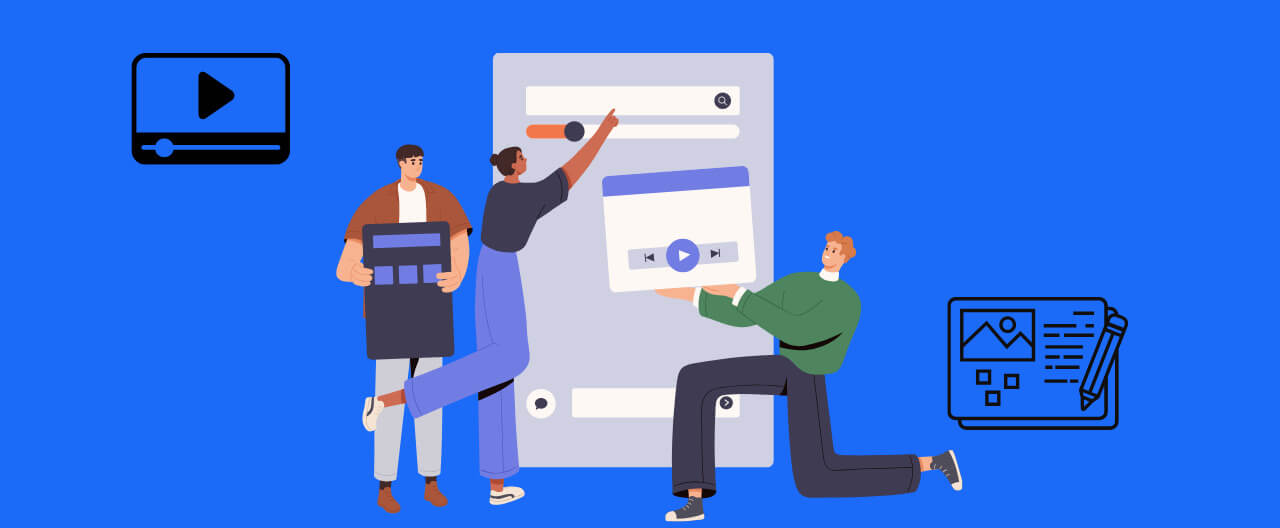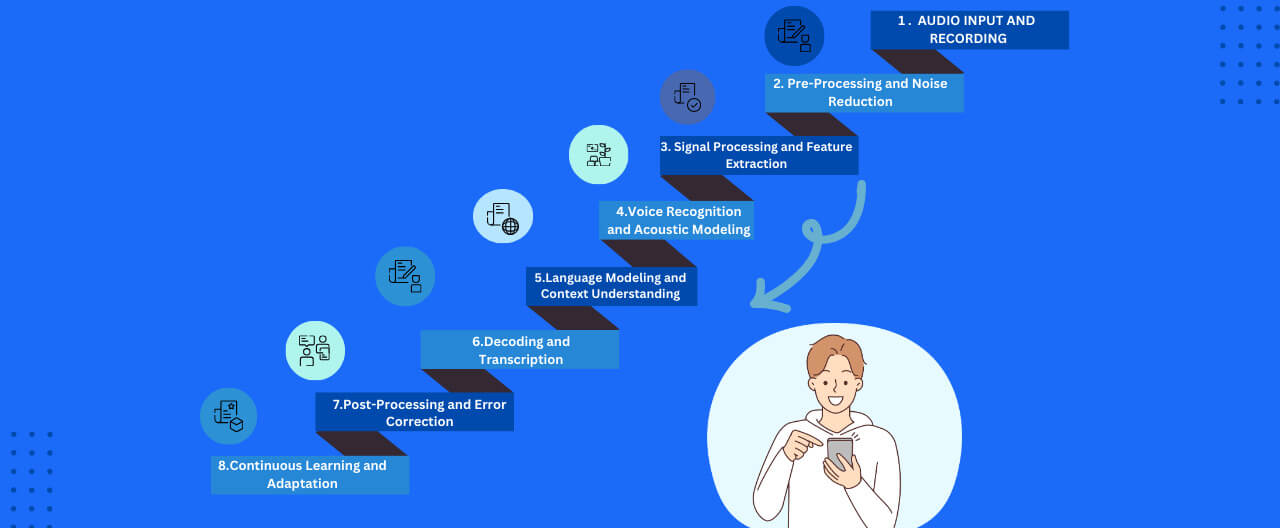We understand it is difficult to convert your thoughts into voice during important meetings, interviews, and lectures. But, on the other hand, with technology at your back, the days of worrying about how to convert audio to text are gone. The era of digital communication has been embraced by everyone. From giant corporations to creators, digital communication has been the new normal. It transitions the use of words into files that can be shared and accessed by others while ensuring that the agenda of the audio or the recording reaches the maximum number of people.
If you’re looking for a simple choice of words, people often refer to it as text transcription; however, the modern and most commonly used term is audio transcription.
What is Audio Transcribing?
Audio transcription is the process of converting spoken language into written text. This is usually done manually by listening to the audio and typing out the words or through an automated approach using software that recognizes and transcribes speech. The transcribed text can then be used for various purposes, such as creating subtitles for videos, generating meeting notes, or archiving important conversations.
Often, creators utilise the magic of audio transcription to increase their reach beyond national boundaries. Additionally, several popular social media platforms, such as YouTube, allow their viewers to gain access to an audio file transcription to supplement their experience of watching the video. Yes, unknowingly, even you would have been one of the receivers of this service.
However, is that the only benefit of audio or text transcription? Think again.
Benefits of Audio Transcribing
Before you decide to take action and quell your curiosity about ‘how to convert audio to text’, let’s delve deeper into the benefits of audio transcribing and why it can be a game-changing aspect for your profession.
Enhancing Accessibility
Transcripts make audio content accessible to individuals with hearing impairments. They can read the text version of the audio, ensuring they don't miss out on important information. Furthermore, transcriptions that translate to different languages help to attract users from different countries.
Facilitating Content Creation and Editing
With an accurate text transcription of your audio recordings, you can streamline the editing process. It allows for easy reference and manipulation of the content, making the creation of articles, blogs, or books more efficient.
Improving Comprehension and Retention
Movies and binge-watching shows have repeatedly proven that reading along with listening can enhance understanding and retention of information. This is particularly useful for students and professionals who need to absorb large amounts of information quickly.
Enabling Searchability
Be it a meeting or a crucial lecture, not every second of the recording would hold weight for you. Skimming through each and every sentence can be an exercise that goes beyond the word tedious. Alternatively, text documents are easier to search, allowing you to quickly find specific information without having to listen through entire recordings.
Supporting Language Learning and Translation
Audio file transcriptions can be a valuable resource for language learning. Users can read along with the audio, improving their comprehension and pronunciation. Additionally, transcripts make it easier to translate content into other languages.
Legal and Compliance Purposes
If you belong to some specific industries, such as legal, medical, and financial services, maintaining accurate records stands at the centre of your responsibilities. Transcribing audio files ensures that there is a reliable, text-based record of important conversations and proceedings, which can be essential for audits, compliance, and legal documentation.
Boosting SEO and Content Engagement
Transcripts can enhance your online presence by making your content more discoverable. Search engines can index the text, improving your SEO rankings. Additionally, providing transcripts can increase user engagement, as people may prefer reading over listening in certain contexts.
Methods of Converting Audio to Text
We’ve discovered the silver linings of audio transcription. It’s time to turn the page and understand how to convert audio to text. There are several methods to convert audio to text, each with its own advantages and disadvantages.
Manual Transcription
The first and oldest mode of transcription is manual transcription, which involves listening to the audio and typing out the spoken words, usually by a professional. This method is considered accurate but time-consuming. It's often used when precision is crucial, such as in legal or medical transcriptions.
Automatic Transcription Using Software Tools
Automatic transcription tools use artificial intelligence to transcribe audio files. These tools are fast and convenient but may struggle with accuracy, especially with poor audio quality or strong accents.
Outsourcing Transcription Services
Outsourcing transcription to professional services can save time and ensure high accuracy. Companies like Konch AI offer reliable transcription services, utilising advanced AI to deliver precise results. Konch AI stands out among transcription tools for its combination of speed, accuracy, and user-friendly interface. Leveraging advanced machine learning algorithms, it can handle various accents and dialects, making it suitable for a global audience.
Steps to Converting Audio to Text Using Konch AI
Do you like straightforward journeys? If so, you’d definitely love using Konch AI for your audio transcriptions.
1. Upload Your Audio File
Start by uploading your audio file to the Konch AI platform.
2. Choose Transcription Options
Select your preferred transcription settings, such as language. With Konch AI, you can avail translations in more than 50 + languages.
3. Initiate Transcription
Click the transcribe button to start the process. Konch AI’s advanced algorithms will convert your audio to text in minutes.
4. Review and Edit
Once the transcription is complete, review the text for errors. You can edit directly within the platform and then save it in your desired format.
Tips for Accurate Transcription
Ensuring Clear Audio Quality
Good audio quality is crucial for accurate transcription. It begins by minimising background noise, ensuring clear pronunciation, and using high-quality recording equipment. Position microphones properly and, if possible, use a quiet environment to record.
Understanding Accents and Dialects
Different accents and dialects can pose challenges for transcription software. Familiarise yourself with the speaker's accent or use a tool like Konch AI, which is designed to handle a variety of accents. Providing context or glossaries for specialised terminology can also improve accuracy.
Proper Punctuation and Formatting
Proper punctuation and formatting are essential for readability. Ensure that the transcribed text is well-punctuated and formatted to convey the correct meaning and tone. Using built-in editing tools within transcription software can help maintain consistency and clarity.
Segmenting Long Recordings
For lengthy recordings, consider breaking the audio into smaller segments. This can improve the accuracy of transcription software by making it easier to process and reducing the likelihood of errors. Additionally, segmenting can make it easier to review and edit the transcript.
Using Speaker Identification
If your recording involves multiple speakers, use a transcription tool, such as Konch AI that offers speaker identification. This feature can distinguish between different voices, attributing the correct text to each speaker, which is particularly useful for meetings, interviews, and conferences.
Reviewing and Editing Thoroughly
Even with advanced transcription tools, it's essential to review and edit the transcript thoroughly. Look for any misheard words, incorrect punctuation, or formatting issues. Taking the time to polish the transcript ensures it accurately reflects the original audio.
Conclusion
Converting audio to text is an invaluable tool in our digital age, offering enhanced accessibility, streamlined content creation, and improved comprehension. Whether you opt for manual transcription, automated software, or outsourcing services, choosing the right method tailored to your needs is crucial. Tools like Konch AI exemplify the advancements in transcription technology, providing efficient, accurate, and user-friendly solutions. Embracing audio transcribing not only maximise productivity but also broadens the reach and impact of your content.
FAQ’s
1. How long does it take to transcribe an hour of audio?
The time required varies based on the transcription method. Manual transcription can take 4-6 hours per hour of audio, while automated tools, such as Konch AI, can transcribe in minutes.
2. Is it legal to transcribe copyrighted audio files for personal use?
Yes, for personal use, it is generally legal to transcribe copyrighted audio files. However, distributing the transcribed content without permission can violate copyright laws.
3. Can transcription software handle background noise in audio recordings?
Advanced transcription software can handle some background noise, but clear audio quality always yields better results.
4. What are the typical costs associated with outsourcing transcription services?
Costs vary widely based on the service provider and the complexity of the audio. Prices can range from $0.10 to $2 per minute of audio.




